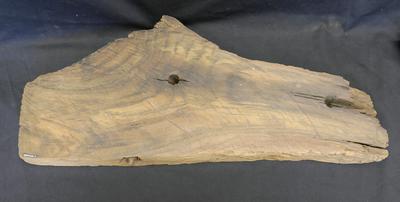rudder; "Charlotte Dundas"
Maker
Hart, Alexander
Production date
1802
Description
Two piece of wood which are remnants of the wooden rudder from the "Charlotte Dundas".
See full details
Object detail
Dimensions:1 - segment:W 26cm (W 10 1/4")
Dimensions:1 - segment:D 4.5cm (D 1 3/4")
Dimensions:2 - segment:L 34cm (L 1' 1 3/8")
Dimensions:2 - segment:W 27.7cm (W 10 7/8")
Among the articles promised for the Ethnographical and Historical Section of the Scottish Exhibition is one from Provost Bogle, Falkirk, which will be viewed with much interest. It is the forefoot of the "first practical steamboat ever built, the Charlotte Dundas," which William Symington of Leadhills built for Lord Dundas of Kerse at Lock 16, Camelon. the engine was of Watt's double acting type, turning a crank on the shaft of the paddle wheel, which was situated at the stern. The vessel was launched early in 1802, and in March of that year she towed along the Forth and Clyde Canal two laden barges each of 70 tons a distance of 20 miles against a strong head wind in six hours. After repeated trials the proprietors of the canal were urged to adopt this new plan of towing, but fearing damage to the banks by the wash from the paddle wheel they refused, and the Charlotte Dundas was put upon the canal bank and gradually broke up. Symington, thoroughly disheartened, abandoned steamship building, leaving the way clear for Henry Bell to succeed with the Comet on the Clyde.
The Provost is also lending a rapier used at the battle of Falkirk in the '45, and found exactly a hundred years later in excavating at the mouth of the North British Railway tunnel at Falkirk High Level Station. Another Falkirk relic which is coming is the stentmaster's chair, bearing the date 1687. The chair was used by the stentmasters until that body ceased to exist in 1859, when it came into the possession of the Provost, Bailies, and Commissioners, who in a local Act of that year were appointed to succeed the stentmasters. They had the charge of the public wells and cisterns of the burgh, and also of the sources of the water, the pipes, and the other water works, and levied assessments for the maintenance of these."
[FH 11 March 1911]


Public comments
Be the first to comment on this object record.